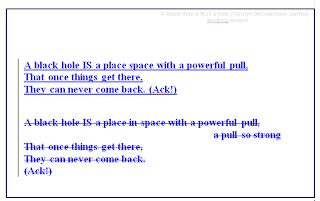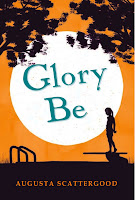 |
| At my celebratory book launch lunch. Double yikes. |
The talented author, Carolyn DeCristofano, is in the house today to talk about her amazing new nonfiction book for children, A Black Hole is NOT a Hole (illustrated by Michael Carroll) and her writing process.
This fascinating book has garnered oodles of rave reviews, including a starred review from Booklist:
 "...this book will snatch readers from their orbits and fling them into a lasting fascination with nature's most attractive phenomena."
"...this book will snatch readers from their orbits and fling them into a lasting fascination with nature's most attractive phenomena."And a starred review from Kirkus:
"Stargazers will be entranced, and even those not especially attuned to matters celestial will come away feeling smarter, awestruck and with a sense of finally understanding this fascinating, other-worldly phenomenon. An excellent resource. Hole-y astronomy!"
So, let's get started!
Carolyn, you have a real gift for making science understandable to those of us who aren't science-oriented. But you also make reading science such a pleasure with your lovely language. Can you tell us a bit about that writing process?
Thank you, Barbara! It’s an honor to hear you use “lovely” to describe my writing!
I am still learning what my writing process is like; here’s what I know so far.
When I have extended periods for writing—which is rare—my process involves a lot of napping and fridge check-ins. You never know when the contents of the fridge are going to spontaneously move around on you. Gotta’ keep your eye on that hummus (or ice cream in the freezer).
 |
| An early draft. From this verse, only the first line made it to publication. Thank goodness! |
I know a few people who would need to have a lot of research under their belts before starting, but I often begin just writing. In this phase, I don’t let facts – or possible mistakes – get in my way. If I’m not sure I understand a concept, then I write what my best understanding is.
This approach feels like cheating. However, it is good for me. It has led me to some new insights about the ideas in my books. I think that this early writing also helps establish my voice in the work, and it focuses my research.
After I draft a section of text, I go back and rework it—many, many times. I crave feedback during this stage. At this point, I am completely disciplined. I can spend a whole day on a few sentences. This is when I get picky about facts.
Can you give an example of a time when writing about a concept before you were sure you understood it led you to new insights?
When I was writing A Black Hole is NOT a Hole and started to tackle Einstein’s theory of relativity, I realized for the first time that Einstein had fundamentally redefined what gravity is. Up until the time when I wrote that section, I thought of Einstein as the guy responsible for telling us about weird time and space effects, but I didn’t really get how all of this was connected to gravity. Having this “Aha” moment allowed me to connect some important dots for readers, hopefully helping them have their own “Aha” moments.
I love the analogies that you use to help young readers understand various scientific concepts. Will you share some examples of that from A Black Hole is Not a Hole?
“A black hole is like a whirlpool”—but not exactly one—is an analogy that appears early in the book. I began with the idea of a tornado, but I realized that tornadoes move around a lot, seem to strike more or less randomly, and do a lot of damage. That’s exactly the opposite of the point I needed to make. My goal for this book was to create an exciting read that avoided the scary imagery that is so often used to describe black holes.
Luckily, the tornado analogy led me to the whirlpool analogy. I like the whirlpool because I think just about every reader has seen water swirl down a drain. It’s immediate and non-threatening. Even Mr. Rogers let us know you can never go down the drain. (To help keep this a “safe” image, the analogy is developed from the perspective of water-loving fish—thanks to fellow writers’ group member Kimberly Marcus. Kim suggested this brilliant idea after I nearly drowned a duck in my first draft!)
One of my favorite analogies is not as extended. I like it because I wanted to be very specific in my description of what happens when a star goes supernova—which is important to understanding how some black holes form. I needed an image that people could really relate to: “The (star) material rebounds like an ocean wave slamming against a rock cliff.” At first I hesitated to use this, because many possible readers live far from the ocean. In the end, I decided that in our video-drenched world, chances are good that the image is at least somewhat familiar.
 |
| The target audience for A Black Hole… is readers aged 9-14. Here I am at 14 (left). |
Which do you think is most critical in conveying information to young readers: the text, the illustrations, the sidebars, or all of the above?
It’s all important—but the text and illustrations are most critical. Every reader needs to find a point of connection, and depending on the day or the person’s learning style or the topic, different elements will serve that role. I didn’t always appreciate that.
Of course, each element, including captions, provides something unique. The sidebars allow for depth and sometimes some extra fun without interrupting the flow of the main storyline. Captions sometimes provide important information. Illustrations bring clarity, emotion, and tone to the ideas in the text. But without the text, the ideas in the illustrations would be incomplete or perhaps ambiguous when, as science illustrations, they should be targeted toward a specific meaning.
Something else I’ve come to appreciate: For the whole piece to work and provide accurate information that really resonates for the reader, all of the elements have to be tuned to the same key.
Can say more about what you mean?
Sure. In one illustration (in A Black Hole is NOT a Hole), a boy is on his way into a black hole. In the text, I’m encouraging readers to take this trip as a thought experiment, realizing that traveling to a black hole is not possible in the foreseeable future.
Mike (Michael Carroll, illustrator) could have chosen to depict an astronaut in full gear. However, for this book, that would not have worked very well. Astronauts in gear are faceless, cold…detached. The astronaut image lends too much realism.
Mike painted this boy as a kid would look on any given day. The reader can identify with the scene and yet see it as fantasy. Any kid can run a thought experiment, and doing so is part of the fun of science and black holes. The illustration conveys that message well.
The overall design is also perfect (--in my opinion; I had nothing to do with it). So often, space books are illustrated in dark colors. A Black Hole… is bright and energetic, thanks to Sue Sherman (the book’s designer) and Mike. There are many colors, beautiful images, generous white space, informal sketches, sassy speech bubbles, and fun sidebars set against a punch of yellow. They signal that the book is energetic, fun, and accessible.
You are also a science educator. How does that work with your writing?
There is a constant competition for time, but each effort benefits from the other. Three years ago, I co-founded Blue Heron STEM Education, an educational consulting company, thinking that this would give me more flexibility than a regular job, thereby supporting my writing life. I was wrong and right. I am busier than ever, but on the other hand, I have flexibility. I enjoy teaching STEM—science, technology, engineering, and math—and it helps me stay in touch with learners and readers of all ages. Also, two different education jobs led to the opportunities to write my first two books. So, in the balance, I guess it works!
 |
| Black hole earrings that I designed and made for author visits. (The shiny metal circles represent X-ray rings around black holes.) |
In your bio on the book flap, it says that you first wrote about science in eighth grade in a note to a classmate: “P.S. Science is S-O-O-O-O-O boring.” What’s the scoop on that?
Oh, that year I really did not enjoy science at all. It was Earth Science. I had to do a science fair project and procrastinated so long that all I could come up with was growing mold, and I even had to borrow some from another classmate! Thank you, Cindy Smith! Anyway, if I remember correctly, someone told the teacher that I was the author of that note, which my teacher had seen when he peered over my friend’s shoulder while she was reading it. He was so great about the situation. He caught me at a quiet moment and complimented me in general. Then he said that science would eventually click for me. He was right. Ironically, the first really big click was about geology, when I learned about how the rocks where I lived showed evidence of two different continents having been crammed together millions of years ago.
What bad writing habit annoys your copy editor the most?
I get hung up on tenses-- especially with if/then language, which is common in science. Sometimes the situation gets pretty convoluted. I might need to convey the past thoughts of a scientist, who was thinking hypothetically while making a prediction. At other times, the reasoning might be happening in the present, as I take readers through a thought process that reflects current ideas. The subjunctive tense comes in sometimes, but not always. I just cannot seem to figure out how to construct these phrases and sentences.
Are there any other bad writing habits that you struggle with?
Yup! As anyone in my writers’ group or Alyssa (Alyssa Mito Pusey, my editor) will tell you, I tend to write the same idea in a lot of different ways, putting a slight twist on each version. Usually, I do this to “explain”—or, as it turns out, over-explain—an idea. I appear not to trust the reader when I write like that, but really, the problem is that I don’t always trust myself to get it right the first (or fourth) time.
Thanks so much for stopping by, Carolyn!
Bye, Barbara. Thanks so much for letting me visit!
*******






































